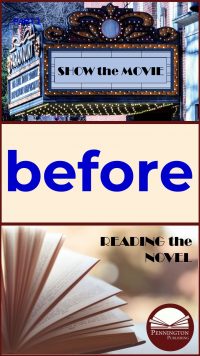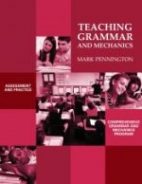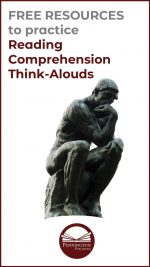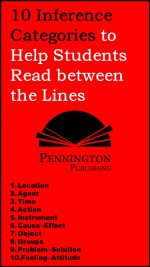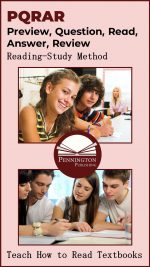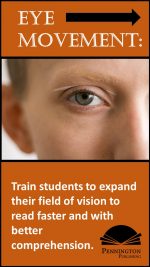Movie First, Book Second
Want your students to get the most out of reading a class novel?
Want more of your students to actually read the whole book?
What to build internal monitoring of the text and increase comprehension?
Show the move first; read the book second.
I know it sound like ELA teacher heresy, but before you hang me like the 19 accused witches in Salem, let me plead my case.
First of all, I am a reading specialist, as well as an ELA teacher. The reading research backs up my position. If we want to build comprehension, maximize vocabulary growth, and engage the author and text, we should front load as much as possible. Activating prior knowledge, scaffolding content vocabulary, reader response theory. Pre-teaching!
My caveats up front: I don’t always show the movie before everything we read. Not every short story or novel has a movie. And I won’t show a bad movie. No one is excited to read the book after watching a bad movie.
Why watch the movie first?
- Watching the movie first levels the playing field. When we read a grade-level novel aloud to the class (listening comprehension), listen to an audio book, or have students independently read, we reward good readers more than poor readers. The Matthew Effect (the rich get richer and the poor get poorer) is reinforced. Good readers understand more, retain more, and perform better on reading quizzes and tests because they are good readers. It’s not a matter of more effort; it’s about reading skills. Poor readers (those reading below grade level) cannot access the same understanding, retention, and achieve the same rewards (good quiz and test grades) because the grade-level text is at the frustration level for them. The fact is that both good and struggling readers benefit from pre-teaching by showing the movie first. The movie simply makes the book more comprehensible. Students are much more likely to be able to read a novel at instructional or independent levels after knowing the characters, plot, theme, and (of course) the visualizations. One final note… no teacher would begin teaching The Diary of Anne Frank by reading page 1. Students obviously need some historical context. The same argument applies to movies first.
- Motivation. We all want our students to achieve the success of reading the whole book. I hear from students (not mine 🙂 all the time that they never finished a novel in middle or high school, including some of the brightest kids making it into prestigious universities. They learned to get by without reading. Online chapter summaries, essays, chat rooms, and movies make it easy. You don’t have to read to succeed. Watching the movie in class before reading takes away the “cheating” incentive. I find, and my students say, they are much more interested in reading the book after watching the movie. The movie piques their interest much more often than it supplants their interest. And yes, kids still always say, “The book was so much better than the movie.” Bottom line? They enjoy reading, say The Outsiders,more and appreciate those literacy components we ELA teachers love, when we show the movie first. As an aside, that’s one movie that is better than the book!
- Improved literary discussions. Starting at a higher level of comprehension enriches class discussions. Students are able to draw from the movie experience to compare and contrast the characters, plot, setting, style, etc. Students are able to analyze the decisions both filmmakers and authors make and evaluate their choices. Because the movie is able to show things that a book can’t and because the book is able to tell things that a movie can’t, students are able to synthesize these relative strengths and gain more insight. That is higher order critical thinking!
Objections
- Watching the movie prior to reading the novel ruins the joy of reader discovery. University professors always assign articles prior to lectures to improve the level of class discourse. (Although I would argue that the reverse procedure might spark more reader independence and out-of-the-box thinking.) A history professor does not cringe at the thought that assigning an article in which you the reader find out that the North won the Civil War will ruin the story for you. Some of you are thinking, ah but that’s non-fiction. I say the same is true for fiction. When the last Harry Potter novel came out (and JK Rowling had announced it was the last), everyone wanted to know whether Harry and Voldemort would die. I won’t speak for adults, but every one of my middle school readers knew the answer within the first day of the book’s release. That knowledge did not spoil the ending. It enhanced the ending. If you’ve ever watched the magicians Penn and Teller explain in advance how one of their tricks is done, and subsequently performs the illusion, you know how much more enriching and enjoyable it is to watch with a bit of inside knowledge. Watching the movie first does just that.
- Watching the movie after reading the book is a reward. I would argue that it’s more of a gap-filler for those who did not or could not read. Teachers who lead discussions on comparing book to movie will spend far less time doing so when the movie is an end-of-the-unit activity. Showing the movie up front provides that comparison throughout the novel.
- I don’t show the movie at all because it confuses students when they read the book. There is some truth to this point with some movies and their books. Elia Kazan’s movie, East of Eden,uses only about half of the plot of Steinbeck’s East of Eden and there are some discrepancies and inconsistencies. However, rather than ending in confusion, a student with the guidance of a good ELA teacher gains far more from the differences than with a novel that has a verbatim screenplay. If given a choice, most ELA teachers would much rather explain and ask students about the differences rather than solely filling in the understanding blanks when reading a novel by itself.
Want five FREE lessons to teach the SCRIP Comprehension Strategies plus a FREE set of SCRIP Posters and Bookmarks sent to your email?
Get the SCRIP Comprehension Strategies FREE Resource:
![]()

The Science of Reading Intervention Program
The Science of Reading Intervention Program: Word Recognition includes explicit, scripted instruction and practice with the 5 Daily Google Slide Activities every reading intervention student needs: 1. Phonemic Awareness and Morphology 2. Blending, Segmenting, and Spelling 3. Sounds and Spellings (including handwriting) 4. Heart Words Practice 5. Sam and Friends Phonics Books (decodables). Plus, digital and printable sound wall cards and speech articulation songs. Print versions are available for all activities. First Half of the Year Program (55 minutes-per-day, 18 weeks)
The Science of Reading Intervention Program: Language Comprehension resources are designed for students who have completed the word recognition program or have demonstrated basic mastery of the alphabetic code and can read with some degree of fluency. The program features the 5 Weekly Language Comprehension Activities: 1. Background Knowledge Mentor Texts 2. Academic Language, Greek and Latin Morphology, Figures of Speech, Connotations, Multiple Meaning Words 3. Syntax in Reading 4. Reading Comprehension Strategies 5. Literacy Knowledge (Narrative and Expository). Second Half of the Year Program (30 minutes-per-day, 18 weeks)
The Science of Reading Intervention Program: Assessment-based Instruction provides diagnostically-based “second chance” instructional resources. The program includes 13 comprehensive assessments and matching instructional resources to fill in the yet-to-be-mastered gaps in phonemic awareness, alphabetic awareness, phonics, fluency (with YouTube modeled readings), Heart Words and Phonics Games, spelling patterns, grammar, usage, and mechanics, syllabication and morphology, executive function shills. Second Half of the Year Program (25 minutes-per-day, 18 weeks)
The Science of Reading Intervention Program BUNDLE includes all 3 program components for the comprehensive, state-of-the-art (and science) grades 4-adult full-year program. Scripted, easy-to-teach, no prep, no need for time-consuming (albeit valuable) LETRS training or O-G certification… Learn as you teach and get results NOW for your students. Print to speech with plenty of speech to print instructional components.
Get the SCRIP Comprehension Strategies FREE Resource:
![]()
Get the Diagnostic ELA and Reading Assessments FREE Resource:
